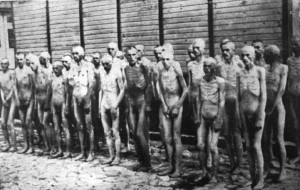Surveillance and Terror. These two terms were used in Sheila Fitzpatricks chapter, A Time of Troubles, as a way of discussing the Great Purges of 1937 and 1938. In this Chapter, Fitzpatrick explored the many ways the Great Terror took hold of the Soviet State and how it spread throughout the state.
The one part of Sheila Fitzpatrick chapter that really stood out to me was her section on how the Great Terror Spread. Fitzpatrick noted that there were several ways that the Great Purge spread. The first was through the “NKDVs practice of interrogation, in which arrested ‘enemies of the people’ would be forced to write confessions naming their conspiratorial associates.” ((Fitzpatrick, Sheila. “Surveillance and Terror” in Everyday Stalinism; Ordinary Life in Extraordinary Times: Soviet Russia in the 1930s, Oxford: Oxford University Press, 1999, 205-206.)) If people found themselves in hot water, whether it was true or not, were forced to write down names of who helped them commit crimes, even if their ‘associates’ actually existed or not. This seemed really interesting to me because it seemed like the state was just as interested in weeding out potential enemies than actual enemies. The states main weapon, in the case of spreading the terror and finding enemies, was the use of fear. The fear of violence, the fear of being sent to Gulags greatly impacted peoples decisions to write down names or tell the state who is an enemy. People were afraid that if they didn’t cough up names, they themselves could have ended up in the Gulag and possibly end up dead.
Within Fitzpatricks section of how the Great Purge spread, the example of how children were used in the process of finding enemies was really interesting. She stated that children thought “catching spies seemed like Great Sport.” ((Fitzpatrick, Sheila. “Surveillance and Terror” in Everyday Stalinism; Ordinary Life in Extraordinary Times: Soviet Russia in the 1930s, Oxford: Oxford University Press, 1999, 207.)) She used an example of a girl named Lena who was on a bus coming back from camp and overheard a man speak in German about “rails” and “Signal”. ((Fitzpatrick, Sheila. “Surveillance and Terror” in Everyday Stalinism; Ordinary Life in Extraordinary Times: Soviet Russia in the 1930s, Oxford: Oxford University Press, 1999, 207.)) This example that Fitzpatrick used was really fascinating to me, but it was also a reminder that children in the Soviet Union were a key component of the states future in the eyes of the party. As Fitzpatrick noted with this example, the minds and behaviors of children were incredibly important and helpful to the state. Not only could the state change their minds through indoctrination, but they could also use these children as spies within homes, within camps, and within schools to rat out enemies of the state. What really intrigues me is why children saw this as a sport? What kind of images or stories would the state use on children to help them see a connection between ‘sport’ and ‘catching spies?’ If there were any rare cases of intelligent children who could see beyond this propaganda game that the State was playing on the children, what do you think might have happened to them?


